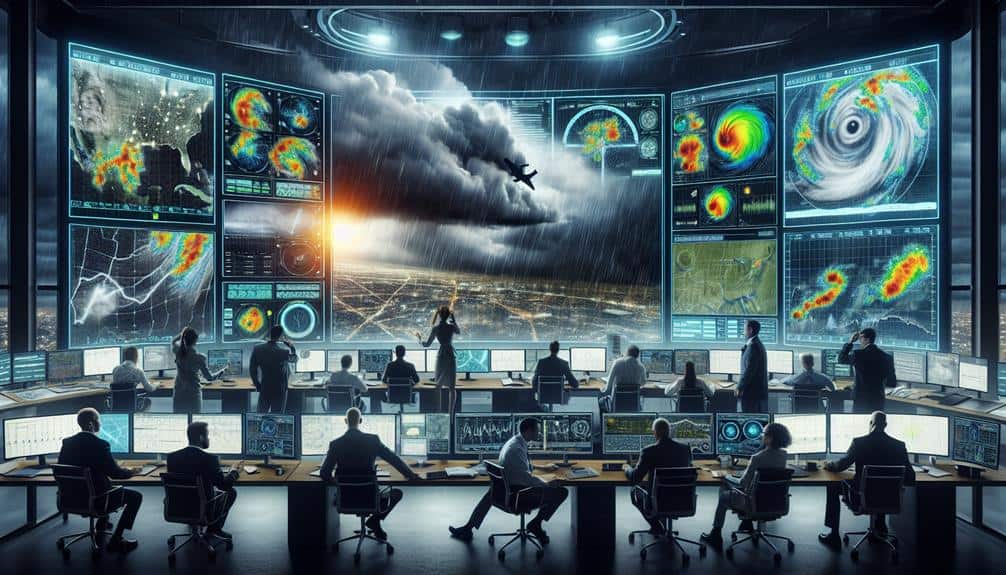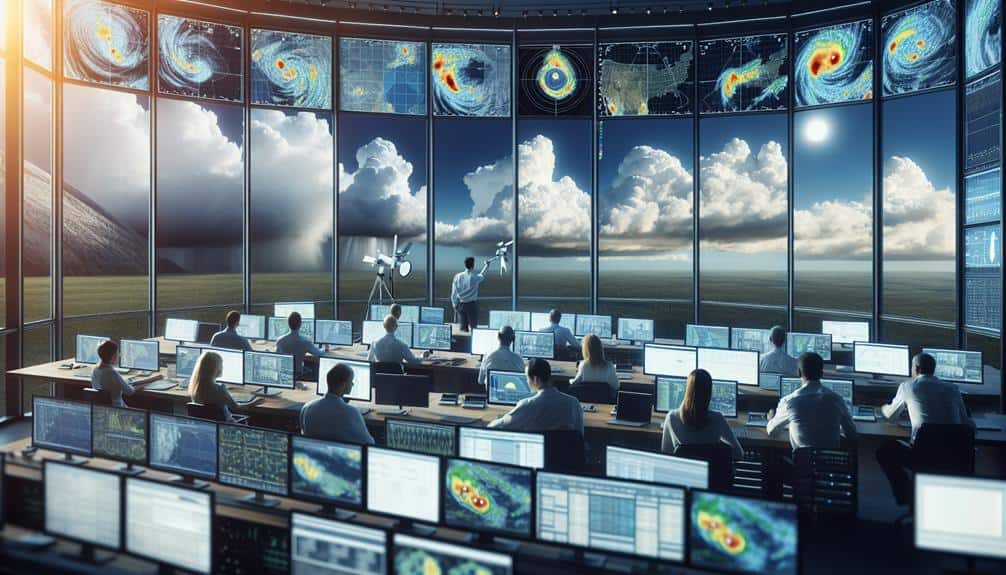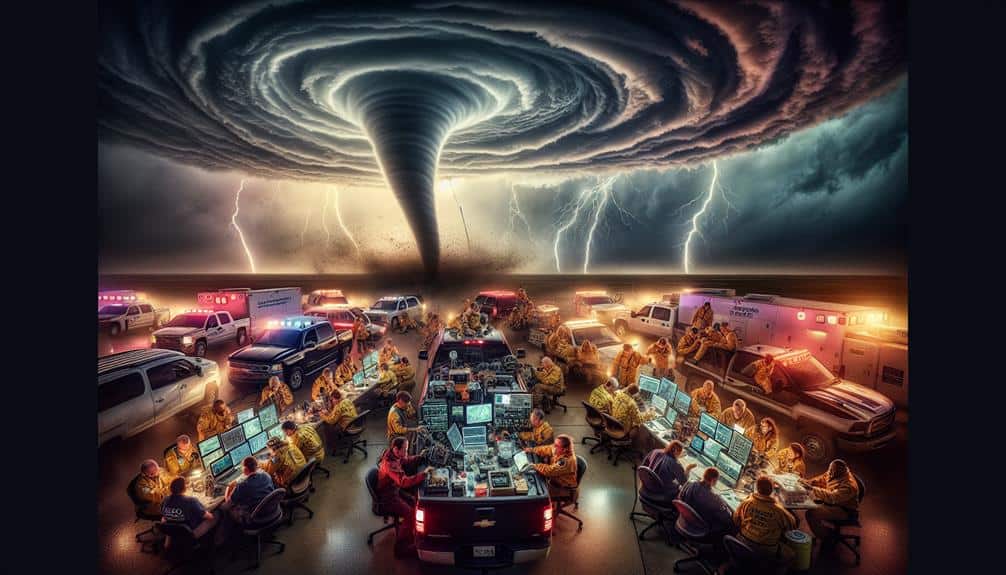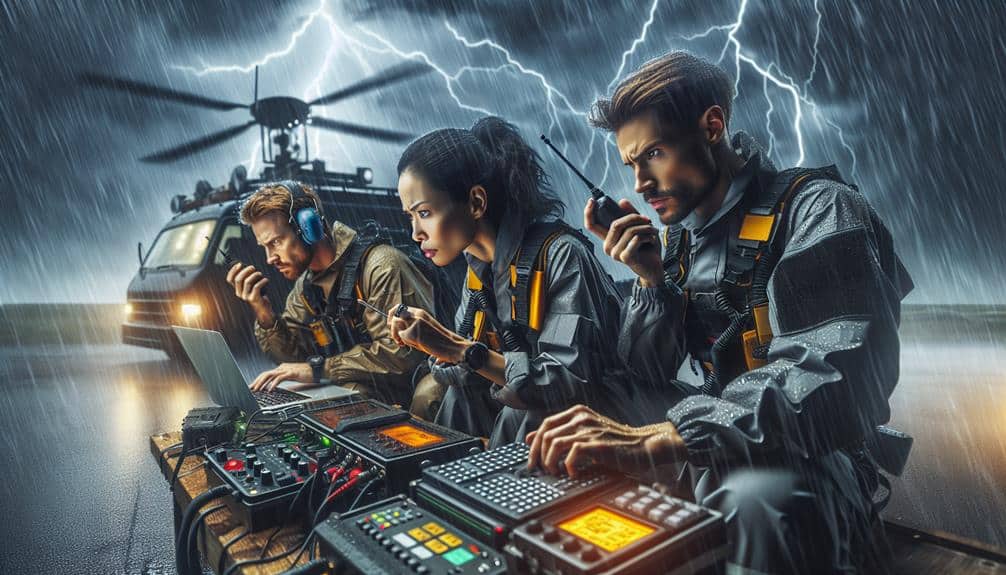We prioritize collaborating with meteorologists to guarantee timely storm warnings, leveraging advanced technology like satellite imagery and computer models. By establishing clear communication protocols and sharing real-time data, we enhance forecast accuracy and guarantee precise updates. Regular briefing sessions keep all stakeholders informed and ready to act. Our thorough understanding of weather patterns and utilization of cutting-edge forecasting tools enable us to predict storms efficiently. This collaboration strengthens our emergency response strategies and improves community safety. If you're interested, you'll uncover the full extent of how these partnerships save lives.
Key Points
- Establish clear communication protocols to ensure timely and accurate storm warnings.
- Integrate advanced technology for real-time data sharing and precise forecasting.
- Conduct regular briefing sessions to keep stakeholders informed about storm developments.
- Utilize data visualization tools to translate complex meteorological data into actionable information.
Understanding Meteorological Data
Meteorological data, which includes information on temperature, humidity, wind speed, and atmospheric pressure, is vital for predicting and understanding storm patterns. To achieve accurate forecasts, we need to carefully analyze this data. By doing so, we can improve forecasting accuracy, providing more dependable storm warnings that allow us to prepare and act freely.
When we immerse ourselves in data interpretation, we're examining detailed aspects that impact weather systems. For example, a slight shift in atmospheric pressure can indicate the formation of a storm. Understanding these subtleties helps us forecast the storm's trajectory and strength. We can't afford to ignore any factor, as each piece of data plays a significant role in the overall picture.
Enhancing forecasting accuracy depends on how effectively we analyze and combine this information. Advanced technology, such as satellite imagery and computer modeling, assists us in this effort. By utilizing these tools, we can make more accurate predictions, enabling us to make well-informed decisions regarding safety measures and resource distribution.
Ultimately, mastering the interpretation of meteorological data empowers us to predict storms more efficiently, ensuring we're always one step ahead. This way, we safeguard our communities and retain our independence in the face of nature's unpredictability.
Building Communication Channels
To guarantee effective storm warnings, we need to establish clear protocols, share real-time data, and hold regular briefing sessions.
Establishing Clear Protocols
One of the most critical steps in ensuring timely storm alerts is establishing clear and efficient communication channels between meteorologists and emergency response teams. To achieve this, we need to focus on protocol refinement and set robust communication standards. By refining our protocols, we can guarantee that the information flow is streamlined, reducing any risk of miscommunication during critical moments.
Next, stakeholder engagement is paramount. We must involve all relevant parties, from local government officials to emergency services, in our planning and execution phases. Engaging these stakeholders ensures everyone is on the same page and understands their roles and responsibilities when a storm alert is issued. This collaboration fosters a cohesive emergency coordination effort, making it easier to mobilize resources and respond promptly.
Additionally, establishing clear communication standards helps eliminate ambiguity. We need to define the language and terminology used, create standardized message formats, and determine the most effective channels for disseminating information. Whether it's through radio alerts, social media updates, or direct communication lines, having these standards in place allows us to convey critical information quickly and accurately.
Real-Time Data Sharing
Effective real-time data sharing is vital for guaranteeing that storm warnings are timely and accurate. By integrating advanced technology into our communication channels, we can enhance forecast accuracy and provide more precise warnings. This integration allows meteorologists to share critical weather data instantly, helping emergency response teams prepare and act swiftly.
We utilize data visualization tools to translate complex meteorological data into clear, actionable information. These tools make it easier for everyone involved in emergency response to understand the severity and trajectory of an approaching storm. By seeing the data in a visual format, decision-makers can quickly grasp the situation and take necessary actions without delay.
Building robust communication channels between meteorologists and emergency responders is essential. We've prioritized real-time data sharing to guarantee that all parties have the latest information at their fingertips. This ongoing flow of information helps us stay ahead of the storm, making sure that communities are well-informed and prepared.
In today's world, where weather patterns can change rapidly, our ability to share and interpret data in real-time can make all the difference. By leveraging technology and focusing on data visualization, we can improve our emergency response and keep our communities safe.
Regular Briefing Sessions
Regular update meetings ensure that all stakeholders stay informed and aligned on the latest storm developments. By establishing consistent communication channels, we make sure that everyone involved in emergency response is up-to-date with the most accurate weather forecasting information. These sessions allow us to discuss evolving conditions, potential impact zones, and necessary precautionary measures, all vital for swift and effective action.
During these briefings, meteorologists provide detailed storm analyses, including data on wind speeds, precipitation levels, and projected paths. This precise information helps emergency response teams prepare adequately, allocate resources efficiently, and make informed decisions to protect lives and properties.
By keeping the lines of communication open, we can rapidly adapt our strategies as new information emerges, ensuring we're always one step ahead of the storm.
Moreover, these regular sessions foster collaboration and trust between meteorologists and emergency planners. When everyone is on the same page, it minimizes the risk of miscommunication and enhances our collective ability to respond swiftly.
Essentially, regular update meetings are the backbone of our storm preparedness efforts, empowering us with the freedom to act decisively and confidently in the face of severe weather.
Sharing Real-Time Updates

Timely sharing of real-time updates is essential to guarantee that communities receive immediate and accurate storm warnings. We rely heavily on emergency notifications to disseminate critical information, keeping everyone informed about potential threats. Social media engagement plays a crucial role in this process; platforms like Twitter and Facebook allow us to reach a vast audience quickly. By utilizing these tools, we can issue updates, respond to inquiries, and correct misinformation on the fly.
Weather tracking through mobile apps has revolutionized how we stay connected with our communities. These apps offer instantaneous updates and alerts directly to users' smartphones, making certain that everyone has the latest information at their fingertips. Push notifications from these apps provide real-time alerts that can save lives by giving people the time they need to take cover or evacuate.
Incorporating these technologies into our communication strategy guarantees that we can deliver accurate and timely warnings, helping communities to prepare and respond effectively. Our collaboration with meteorologists and tech platforms makes it possible to stay ahead of the storm, giving everyone the freedom to make informed decisions when it matters most.
Analyzing Weather Patterns
Understanding and predicting weather patterns is key to issuing accurate storm warnings and safeguarding our communities. By analyzing historical data and current conditions, we can make informed decisions about potential weather events.
Weather prediction isn't just about looking at clouds; it involves understanding atmospheric pressure, temperature changes, and wind patterns. This detailed analysis helps us anticipate storms before they develop, giving us valuable time to warn the public.
Storm tracking plays an essential role in this process. By closely monitoring storm movements, we can determine their speed, direction, and potential impact areas. This information allows us to provide timely updates and accurate warnings, ensuring that everyone has the opportunity to prepare and stay safe. We rely on a combination of satellite imagery, radar data, and ground-based observations to track these storms in real-time.
Collaborating with meteorologists enhances our ability to analyze weather patterns effectively. Their expertise and experience bring depth to our understanding, allowing for more precise weather prediction. Together, we can decode the complexities of weather systems and improve our storm tracking capabilities.
This collaboration is crucial to our mission of protecting lives and property through timely and accurate storm warnings.
Utilizing Forecasting Tools

When we use advanced forecasting tools, we enhance our ability to predict and respond to storms with greater precision. By leveraging cutting-edge technology, we improve storm tracking capabilities, allowing us to monitor storm development in real time. This means we can provide more accurate and timely warnings, giving communities the information they need to stay safe and make informed decisions.
Our use of satellite imagery, radar systems, and computer models plays an essential role in improving forecast accuracy. These tools help us analyze various atmospheric conditions, such as wind speed, humidity, and pressure, enabling us to predict the path and intensity of storms more reliably. The integration of these tools into our meteorological practices ensures that we can offer more precise and detailed forecasts.
Advanced forecasting tools also facilitate collaboration with meteorologists, making sure that we all have access to the latest data and insights. This collaborative effort is crucial to refining our storm tracking methods and enhancing our overall predictive capabilities. By embracing these technologies, we empower ourselves and our communities to face storm threats with confidence and resilience, reinforcing our commitment to safety and preparedness.
Enhancing Response Strategies
To enhance our response strategies, we need to integrate real-time data effectively and improve our community alert systems. By working closely with meteorologists, we can guarantee our emergency preparedness plans are robust and actionable.
Let's focus on using these tools to keep our communities safe and informed.
Real-Time Data Integration
By integrating current data from meteorologists, we can enhance our storm response strategies and ensure timely warnings. Leveraging this data integration allows us to make well-informed decisions quickly, guaranteeing that we remain agile and effective in our response efforts. The accuracy and immediacy of real-time data can greatly improve our ability to predict and react to storm developments.
Effective communication channels are pivotal in this process. By establishing robust channels, we guarantee that critical information flows smoothly between meteorologists, emergency responders, and the public. This interconnected system enables us to disseminate warnings swiftly and accurately, minimizing confusion and maximizing safety.
Key benefits of real-time data integration include:
- Enhanced Predictive Models: Real-time data feeds improve the accuracy of storm tracking and prediction models, allowing us to foresee potential impacts more precisely.
- Rapid Decision-Making: Immediate access to updated information empowers us to make quick decisions, optimizing our response strategies and resource allocation.
Community Alert Systems
We must implement strong community alert systems to ensure that storm warnings reach everyone swiftly and effectively. By doing so, we enhance public safety and empower individuals to take immediate, appropriate action.
Our warning systems need to be multifaceted, utilizing various communication channels such as text messages, radio broadcasts, social media, and dedicated apps. This approach maximizes the chances of reaching a broad audience, including those without constant internet access.
We should also consider the importance of localized alerts. These systems should provide specific information relevant to different neighborhoods, enabling residents to respond without unnecessary panic. Integrating real-time data from meteorologists allows us to offer precise updates that reflect the current situation accurately.
Moreover, community engagement plays a crucial role. We need to educate and involve residents in understanding how these warning systems work. When people know what to expect and how to react, they're more likely to trust the alerts and act promptly.
By prioritizing public safety through efficient warning systems, we not only safeguard lives but also uphold the freedom of our communities to live without constant fear of natural disasters.
Let's work together to make our alert systems as efficient as possible.
Emergency Preparedness Plans
Developing strong emergency preparedness plans guarantees that our communities can respond swiftly and effectively when storms strike. By collaborating with meteorologists, we can enhance our response strategies, ensuring everyone knows what to do before, during, and after a storm.
A key component of our plans involves clearly marked evacuation routes and accessible emergency shelters. These routes need to be well-publicized and regularly updated to account for any changes in infrastructure or population dynamics.
Effective family communication is another cornerstone of preparedness. Each family should have a robust plan that includes meeting points, emergency contacts, and ways to stay informed about the storm's progress. In today's digital age, having reliable communication channels can make all the difference.
Lastly, maintaining a well-stocked supply of emergency supplies is essential. Each household should have a kit that includes necessities such as water, non-perishable food, medications, and first-aid items.
- Evacuation routes: Clearly marked and regularly updated.
- Emergency shelters: Accessible and well-publicized.
Frequently Asked Questions
How Do Meteorologists Handle Unpredictable Weather Conditions?
We rely on meteorologists to analyze weather patterns and provide emergency response updates. When weather conditions are unpredictable, they use advanced tools to make real-time adjustments, ensuring we stay informed and free to make safe decisions.
What Qualifications Are Needed to Become a Meteorologist?
To become a meteorologist, we need to meet specific meteorology education requirements, typically a bachelor's degree in meteorology or atmospheric science. Career opportunities for meteorologists include forecasting, research, academia, and roles in government or private sectors.
Can Meteorologists Predict the Impact of Climate Change on Storms?
We can predict the impact of climate change on storms by conducting impact assessments and analyzing climatic trends. This approach allows us to understand potential changes and prepare, without compromising our freedom to live and act.
How Do Meteorologists Collaborate With International Weather Agencies?
We collaborate with international weather agencies through strong international partnerships and data sharing. By pooling resources and expertise, we enhance our ability to predict and respond to global weather events, ensuring timely and accurate storm warnings for all.
What Technologies Are Emerging in the Field of Meteorology?
We're on the brink of a weather revolution! Emerging technologies like weather satellites and artificial intelligence are transforming meteorology. These advancements promise unprecedented accuracy and timely forecasts, giving us more freedom to plan and stay safe.


